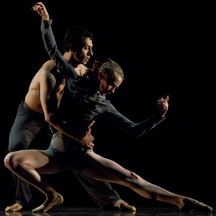
Cal Performances delights, and rightly so, in the presentation of innovative and avant-garde productions. This past weekend they presented the Australian Ballet’s Swan Lake, choreographer Graeme Murphy’s revision of the great Romantic ballet that premiered in 1877 at Moscow’s Bolshoi Theater.
Since the late-19th century the ballet has gone through countless revisions, rather like Stravinsky’s Rite of Spring. Every choreographer worth an international reputation takes a shot at it. But few completely discard the ballet’s original choreography by Marius Petipa and Lev Ivanov. Even Murphy retains many of the original moves of the ballet, his second act echoes and re-echoes the familiar lines of white swans, the quick-stepped choreography of the four cygnets and the jetés of the “guardian” swans as they move diagonally across the moonlit stage. Only the pas de deux between Prince Siegfried and Odette, the Swan Queen, is less recognizable in its updated form.
What has changed radically, though, is the story. At times Murphy’s acrobatic and contemporary sense of choreography, which well-showcases the many talents and skills of this outstanding ballet company, discards the elegant steps of the original, which often showcase technical virtuosity in a simple display of bravura (really, do we need to count those 32 fouetté turns?). But a greater violence is done to the ballet when its story is discarded. For the power of this ballet lies in the mystery of its story.
The metaphors of Swan Lake are taken from a mythology that arises from the deep recesses of the global mind. In it, a woman is transformed into a swan by an arbitrary and evil sorcerer. She can only be released into her own humanity by a true and unwavering love. Prince Siegfried embodies that release, but he fails in his constancy. Enchanted by an illusion that he believes is the Swan Queen Odette, he pledges his love to the Black Swan Odile.
In a questionable attempt to modernize the story, Artistic Director David McAllister has realigned the story along a contemporary myth: that of the love triangle of Princess Diana, Prince Charles and Camilla Parker-Bowles. This is more of a PR angle than a true reflection of the ballet. Apart from the idea of a love triangle among royals, there’s not much on stage that resembles events off stage. We may think we know what happened in this “royal” love triangle, but between the sordid sensationalism of the tabloids and the royal families clamp-down on mainstream news we have only a distorted and limited view of Charles and Diana’s unhappy marriage. Do we really want more? Probably not. According to reports, it is McAllister, not Murphy, who opted for this reading.
What this version’s story more resembles is Giselle, in which a narcissistic and fickle prince woos and then abandons a young village girl, who because of her own fragility then lapses into madness. In Giselle, however, we only have to sit through a two-minute mad scene. In Murphy’s Swan Lake, we get a two-hour mad scene.
Gone then are the innocence and purity of the original. More importantly, gone is the idea that love can be a transformative and saving impulse. For at the end of the Petipa-Ivanov ballet, Prince Siegfried returns to Odette. And the two, through the depth of their love, are able to destroy the evil sorcerer, though the price is their mutual deaths – deaths that they understand ensure their eternal bond to each other.
All this is written not only in the ballet’s choreography but also in its memorable and deeply moving music. It has occurred to me several times that the metaphors of this ballet must have matched Tchaikovsky’s own melancholic and frustrated love. The mysterious woodwinds that symbolize the world of the swans – a separate, inhuman and incommunicable world – and the triumphant horns and insistent strings that rise at the ballet’s end to describe the lovers’ apotheosis. All add to the power of the ballet’s enduring appeal.
Berkeley Symphony did a terrific job under the baton of Australian Ballet’s Music Director and Chief Conductor Nicolette Fraillon. The score itself had parts moved and several of the character dances from the third act disappeared. That may be confusing for aficionados of the traditional version.
The costumes by Kristian Fredrikson were terrific, especially the Romantic tutus for the swan corps de ballet, which were shortened and layered like feathers.
Finally, the dancers were indeed splendid. Amber Scott danced a fragile and mournful Odette and Lana Jones a fiery Baroness von Rothbart (Odile). Adam Bull looked svelte and masculine dancing Prince Siegfried in a three-piece suit. There was a delightfully charming duet by Reiko Hombo and Rudy Hawkes.
—Jaime Robles
Photo: Amber Scott as Odette and Adam Bull as Prince Siegfried. Photo by Jeff Busby.
